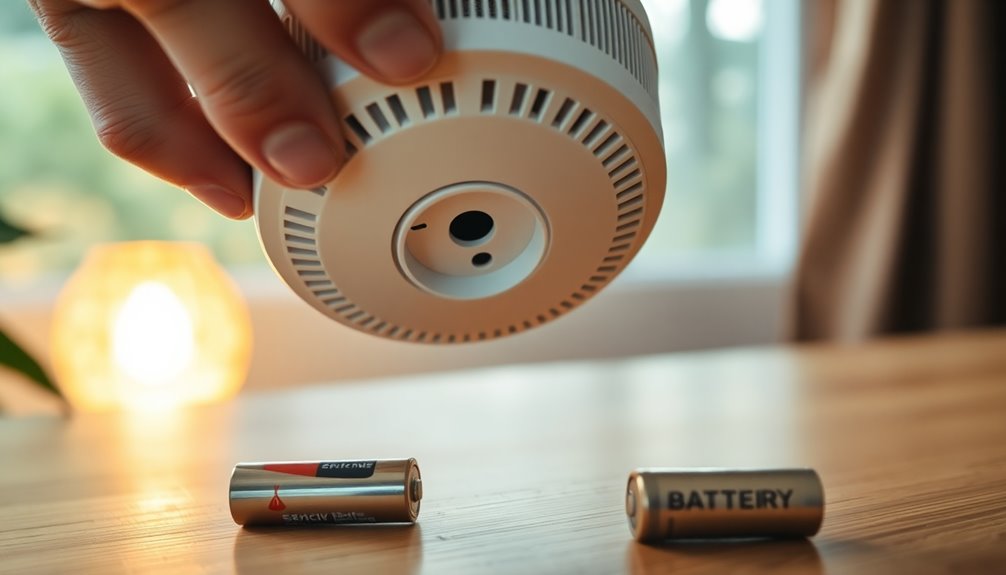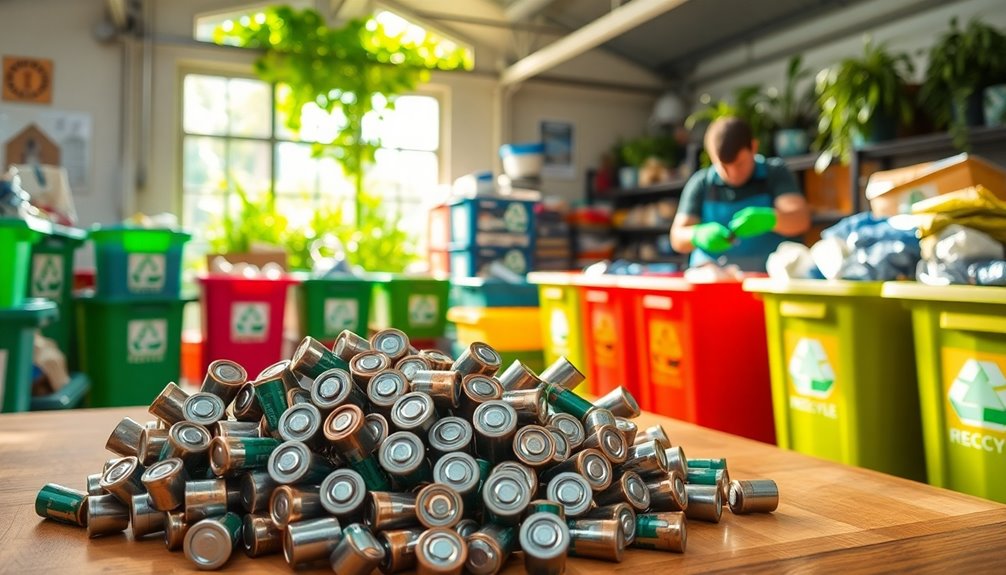Solar batteries usually last between 5 to 15 years, depending on the type you choose. Lithium-ion batteries are the top performers, lasting around 10 to 15 years, while lead-acid batteries typically last only 3 to 5 years. Factors like depth of discharge, temperature, and regular maintenance play a significant role in their longevity. To extend your battery's lifespan, try to keep the charge cycles shallow, maintain ideal temperatures, and perform routine checks. With the right knowledge and care, you can maximize your investment. Curious about how to enhance your battery performance? There's plenty more to explore!
Key Takeaways
- Solar batteries typically last between 5 to 15 years, depending on the type and usage conditions.
- Lithium-ion batteries outperform lead-acid, lasting 10 to 15 years compared to 3 to 5 years for lead-acid.
- Factors like depth of discharge, temperature, and maintenance practices significantly influence battery lifespan.
- Regular monitoring and shallow cycling can extend battery life and optimize performance.
- Investing in solar batteries can lead to long-term savings and increased energy independence.
Understanding Solar Batteries
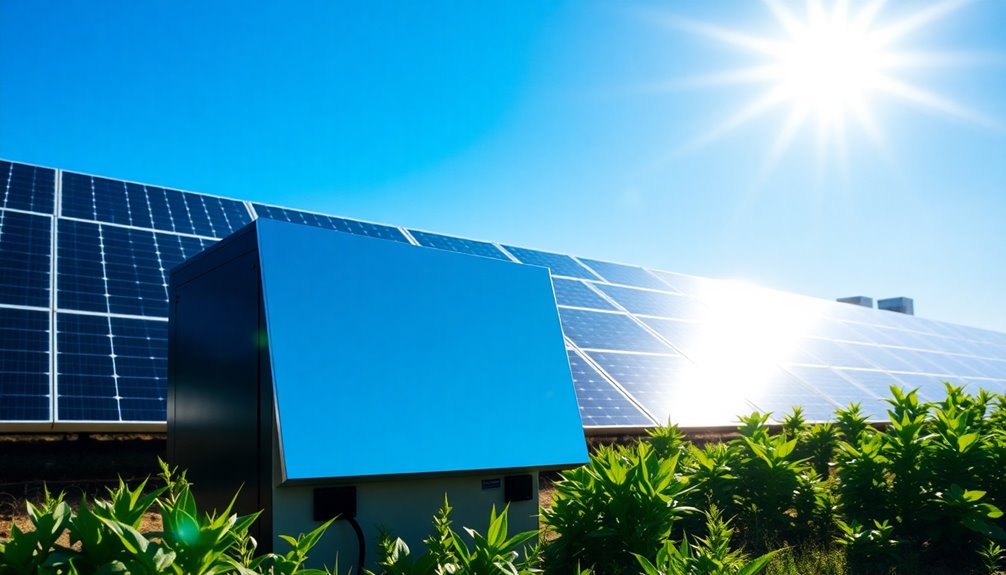
When you harness solar energy, understanding how solar batteries work is vital to maximizing their benefits.
Solar batteries store excess energy generated by your solar power system, ensuring you've got power during outages or at night.
The lifespan of solar batteries typically ranges from 5 to 15 years, with lithium-ion batteries outperforming lead-acid batteries.
Battery longevity hinges on factors like depth of discharge (DoD), temperature extremes, and maintenance.
Regular upkeep, such as cleaning terminals and inspecting for damage, can enhance performance.
Choosing the right battery type is important; lithium-ion offers higher efficiency, while lead-acid may be more affordable.
Lifespan of Solar Batteries
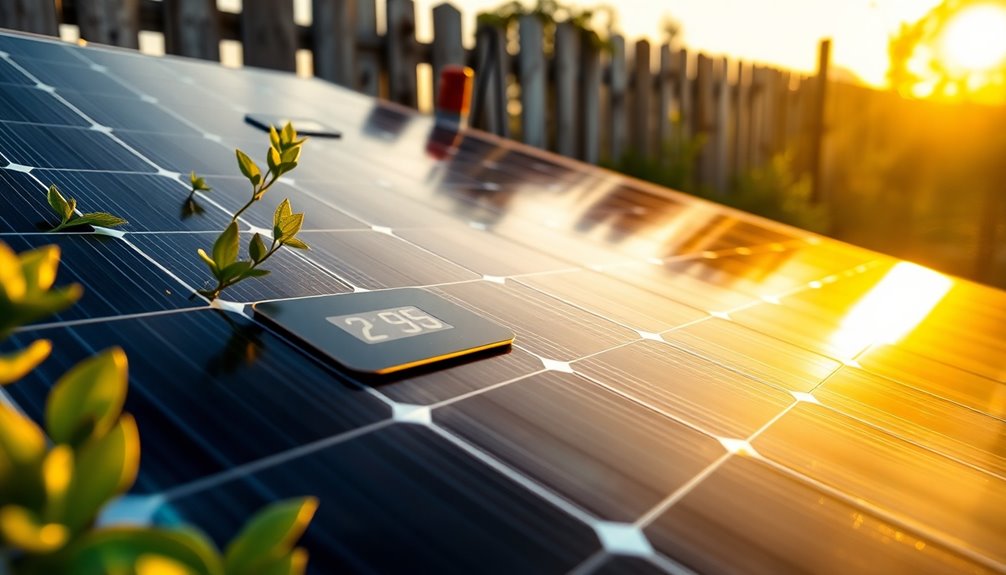
The lifespan of solar batteries is a crucial factor for anyone considering solar energy solutions. Typically, lithium-ion solar batteries last between 10 to 15 years, while Lead Acid batteries range from 3 to 5 years.
If you opt for Lithium Iron Phosphate (LFP) batteries, expect a lifespan over 10 years. Performance degradation starts after numerous cycles, especially when a battery can only recharge to 60% of its original capacity.
Factors like depth of discharge (DoD) and operational temperature play a significant role in determining solar battery lifespan. Regular maintenance practices can enhance life expectancy, particularly for lithium-ion batteries.
Factors Influencing Battery Longevity

While various elements contribute to the longevity of solar batteries, understanding these factors can help you maximize your investment.
The type of battery you choose greatly impacts how long your solar battery lasts; lithium-ion batteries offer a lifespan of 10-15 years, while lead-acid batteries only last 3-5 years.
Depth of discharge (DoD) is essential—exceeding recommended levels can shorten your battery's life, particularly for lead-acid types.
Operating temperatures also matter; aim for 60-70°F (16-21°C) to optimize performance, as extreme temperatures can accelerate degradation.
Frequent cycling will wear your batteries faster, so be mindful of how often you charge and discharge.
Finally, regular maintenance like cleaning terminals enhances battery performance and longevity.
Types of Solar Batteries
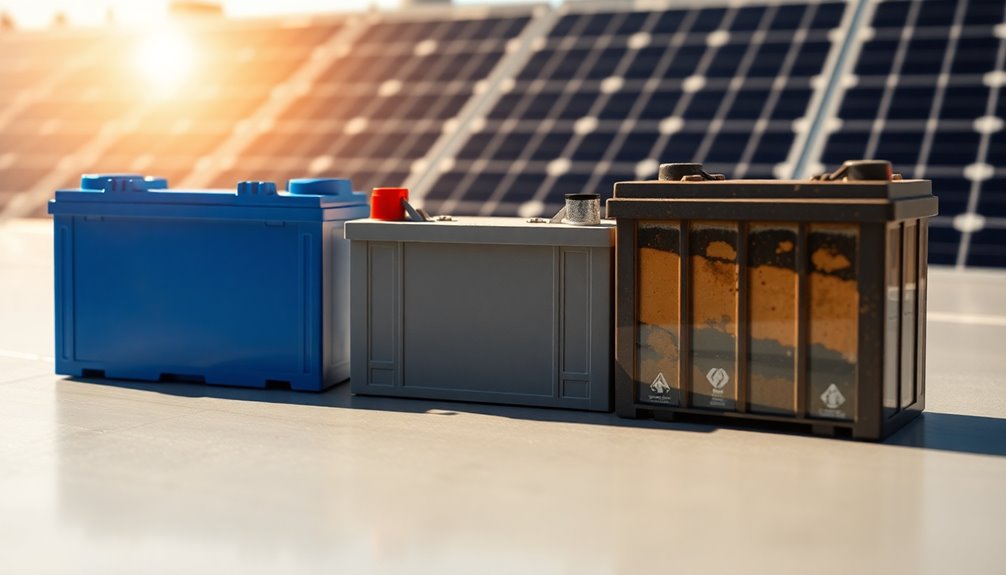
When choosing a solar battery, you'll encounter various options, each with its pros and cons.
Lead-acid batteries are widely used but require more maintenance and have a shorter lifespan.
On the other hand, lithium-ion batteries offer significant advantages in efficiency and longevity, making them a popular choice for modern solar systems.
Lead-Acid Batteries Overview
Lead-acid batteries stand out as the oldest and most widely used type of solar battery, offering a practical solution for many users.
These batteries typically last between 3 to 5 years, although with infrequent use, they can extend to 12 years.
You'll find two main types: flooded lead-acid, which requires regular maintenance, and sealed types that are more convenient but slightly less efficient.
With a lower initial cost, lead-acid batteries appeal to budget-conscious consumers.
However, they've a lower depth of discharge (DoD) capability, usually around 50%, meaning they shouldn't be discharged beyond this level.
Despite their shorter lifespan and higher maintenance requirements, they're a common type in off-grid systems and reliable energy sources for various applications.
Lithium-Ion Advantages Explained
Solar battery technology has evolved considerably, with lithium-ion batteries emerging as a standout option for energy storage. Their impressive lifespan of 10 to 15 years greatly surpasses lead-acid batteries, which only last 3 to 5 years.
You'll appreciate their higher efficiency and greater depth of discharge (DoD), enabling up to 80% discharge without damage. For residential solar setups, lithium-ion batteries are compact and require minimal maintenance.
- Advanced technologies like Lithium Iron Phosphate (LFP) enhance longevity and stability.
- Performance remains consistent across various temperature conditions.
- Ideal operating temperature is between 60-70°F (16-21°C).
- LFP can potentially last over a decade.
- These batteries offer a reliable energy solution for modern energy needs.
Maintenance and Care
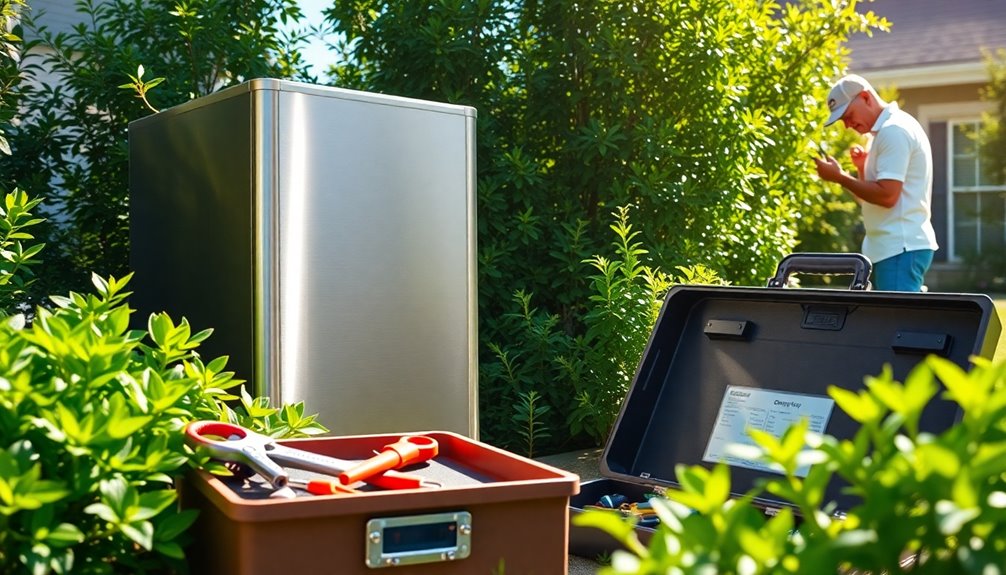
To keep your solar batteries performing at their best and extend their lifespan, regular maintenance is crucial.
Start by monitoring the battery charge, especially for lithium-ion types, to guarantee peak performance. Keep the terminals clean and free of debris to enhance connectivity and efficiency.
Conduct frequent visual inspections to spot any signs of wear, leaks, or damage, particularly in lead-acid batteries, which require more care. For lithium-ion batteries, occasional state of charge checks suffice; however, lead-acid types need regular electrolyte level checks.
Utilizing Battery Management Systems (BMS) can help you track battery health and performance, facilitating timely maintenance.
Signs of Battery Replacement
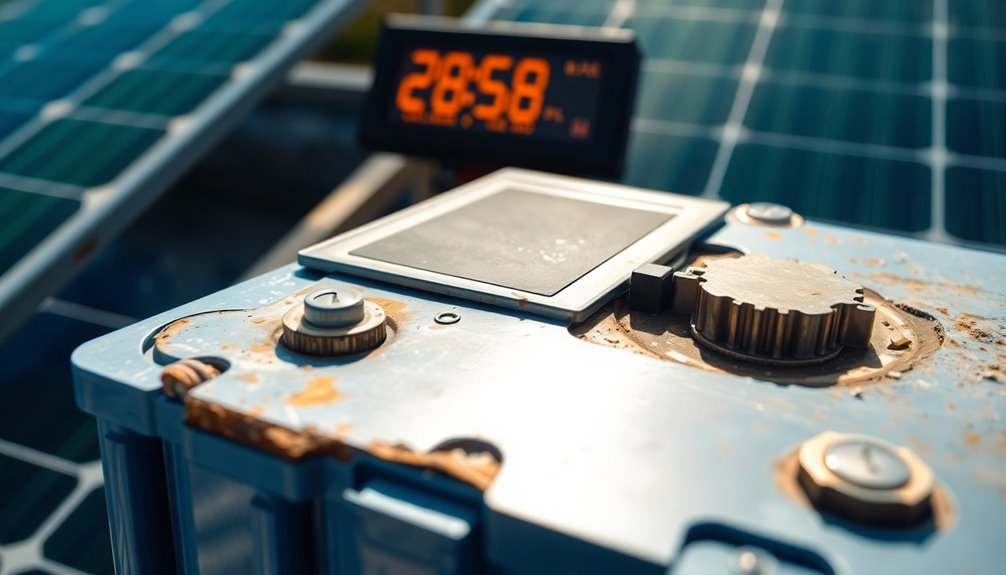
You should watch for signs that your solar battery needs replacement.
Look for visible damage like leaks or bulges, and pay attention to how well it holds a charge.
If you're noticing decreased efficiency or performance issues, it might be time to contemplate a new battery.
Visible Physical Damage
When visible physical damage occurs on solar batteries, it's vital to act quickly to guarantee safety and functionality. Signs like exposed terminals or leaks indicate that replacement is necessary.
Bulges or bumps on the battery surface often signal internal failure, compromising performance. Regular inspections are important; catching wear and tear early can extend the lifespan of your solar battery system.
Here are some key signs to watch for:
- Exposed terminals that show corrosion
- Leaks or fluid buildup around the battery
- Bulges or deformations on the battery casing
- Significant charging times that are unusually long
- Reduced efficiency in holding a charge
Addressing these issues promptly secures peak performance and prevents further battery degradation.
Decreased Charging Efficiency
As batteries age, their charging efficiency often declines, making it essential to recognize the signs of potential replacement.
If you notice that your battery takes considerably longer to reach a full charge, it could indicate decreased charging efficiency due to internal resistance or capacity loss.
A battery that can't hold more than 60% of its original energy storage capacity signals severe performance degradation and likely requires replacement.
Frequent shutdowns during high-demand periods also hint at diminished efficiency.
Additionally, increased heating during charging is a critical sign that your battery's lifespan is nearing its end.
Regular performance checks can help you identify these issues, ensuring timely replacement and ideal power delivery for your energy needs.
Performance Monitoring Indicators
Recognizing performance monitoring indicators is essential for maintaining the efficiency of your solar battery.
Keep an eye out for these signs that might suggest it's time for a replacement:
- Decreased efficiency: The battery struggles to hold a charge or delivers less power.
- Increased charging time: It takes longer to recharge than when new.
- Physical damage: Look for bulges or leaks on the battery surface.
- Frequent recharging: You'll notice the need to top it up more often, indicating reduced battery capacity.
- Temperature monitoring: Elevated internal temperatures can signal potential failure.
Maximizing Battery Performance
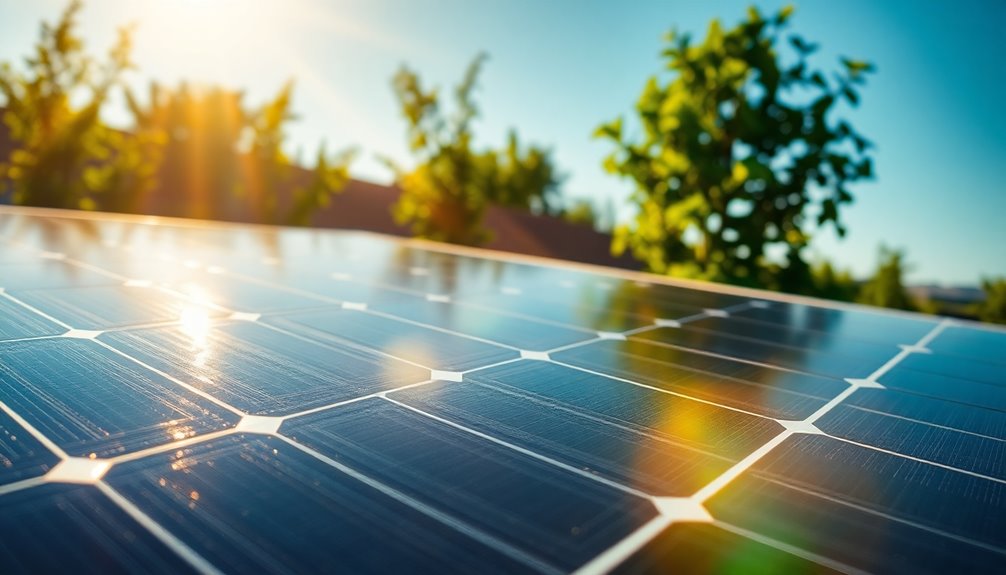
To maximize your solar battery's performance, it is crucial to keep the Depth of Discharge (DoD) below 80%. Regular maintenance is key; clean battery terminals to improve conductivity and monitor temperature, keeping it between 60-70°F (16-21°C) to prevent degradation. Implementing a Battery Management System (BMS) can help you track performance and health.
Here's a simple table to illustrate effective practices:
| Practice | Benefit | Frequency |
|---|---|---|
| Maintain DoD < 80% | Extends lifespan | Daily |
| Regular cleaning | Enhances conductivity | Monthly |
| Monitor temperature | Prevents accelerated wear | Weekly |
| Shallow cycling | Slows degradation | As needed |
| Use BMS | Tracks performance | Continuous |
Role in Power Reliability

Solar batteries play an essential role in guaranteeing power reliability by storing excess energy generated by your solar panels. This stored energy becomes vital during non-sunny periods, providing backup power during outages and enhancing your energy independence.
By optimizing energy usage, solar batteries help minimize costs and inconveniences associated with power disruptions.
- They support grid stability by reducing peak demand.
- Understanding your household energy consumption patterns can extend the lifespan of your solar battery systems.
- They guarantee essential electronics stay operational during outages.
- Solar batteries contribute to overall energy resilience.
- An efficient solar battery system can improve performance and reliability.
Investing in solar batteries means you're securing a reliable power source for your home.
Frequently Asked Questions
How Long Do Solar Batteries Last?
When you're considering solar batteries, their lifespan typically ranges from 5 to 15 years, depending on the type.
Lithium-ion batteries tend to last longer, around 10 to 15 years, while lead-acid batteries might only last 3 to 5 years.
Factors like depth of discharge, temperature, and maintenance practices can greatly affect their longevity.
How Long Do Solar Light Batteries Last?
Think of solar light batteries as the heartbeat of your outdoor lighting. They typically last between 1 to 3 years, depending on the type and conditions.
If you're using nickel-metal hydride (NiMH) or lithium-ion batteries, the latter usually outlasts the former.
Keep an eye out for signs like dimming lights or longer charging times; these indicate it's time for a replacement.
Regular maintenance can extend their life, so don't forget to clean those solar panels!
How Long Can You Run off a Solar Battery?
You can typically run off a solar battery for several hours to a couple of days, depending on its capacity and your energy consumption.
A fully charged lithium-ion battery can power essential appliances for about 24 to 48 hours during an outage.
The depth of discharge also affects how long you can use it, so managing your energy efficiently can extend its usability considerably during low sunlight conditions or power outages.
What Is the Lifespan of a Lithium Solar Battery?
You might think your lithium solar battery's lifespan is a mystery, but it's actually pretty straightforward.
Typically, you'll enjoy 10 to 15 years of reliable service, far outpacing those old lead-acid batteries that barely last a few years.
Keep in mind that factors like depth of discharge and temperature can help or hinder performance.
Conclusion
To summarize, understanding solar batteries is essential for anyone looking to harness the sun's power. With proper care and maintenance, these batteries can last for years, providing reliable energy and saving you money. Keep an eye out for signs of wear, and don't underestimate the impact of temperature and usage on their lifespan. After all, a well-maintained solar battery can feel like having a miniature sun at your fingertips, lighting up your life for countless days ahead!


